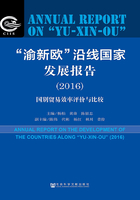
Abstract
The national trade efficiency is an important index to indicate a country's competitiveness in the international market and its potential in the international trade cooperation. It is also a significant reference to the options of international trade partners. The improvement of national trade efficiency can not only enhance a country's competitiveness in the international market, but also provide other countries an important reference to choose their favorable partners. The“Belt and Road”(B&R)initiative links China and the world more closely. In order to promote the world economy to achieve a healthy, stable and sustainable development, we must study the trade efficiency of all countries in the world. The research, especially based on Chongqing, should involve the countries along the“Yu-xin-ou”Railway. The research can be very helpful to the promotion of the B&R initiative. Due to these reasons, the evaluation of the trade efficiency of the countries along the“Yu-sin-ou”Railway has drawn more and more attentions from the academic field and the strategic decision makers of all countries.
25 countries along the“Yu-sin-ou”Railway are selected to be studied on the development level, change features, and intrinsic forces of their national trade efficiency during the period of 10 years from 2005-2014. This book is divided into three parts. The first part is the general report of the evaluation of the trade efficiency development level of these 25 countries along the“Yu-sin-ou”Railway, presenting their advantages and disadvantages and change features, then analyzing the new national trade trends and patterns of Eurasian countries under the new situations in order to provide some valuable analysis for the improvement of China's international trade efficiency and options of target trade partners. The second part is the theory and methodology, presenting the significance, contents, and technical route of this research. Based on the characteristics of national trade efficiency of countries along“Yu-xin-ou”Railway, an index system and a mathematical model are constructed, which forms a complete analysis framework. The third part is the reports of 25 countries on the evaluation of their national trade efficiency respectively, which include in- depth and scientific contrast and analysis, indicating their own characteristics and relative differences so as to provide the valuable data basis for the options of our future key trade partners. In the end, the appendix exhibits all information related to this research for readers to refer to, which includes datum and tables of the evaluation of national trade efficiency of countries along“Yu-xin-ou”Railway from 2005-2014.